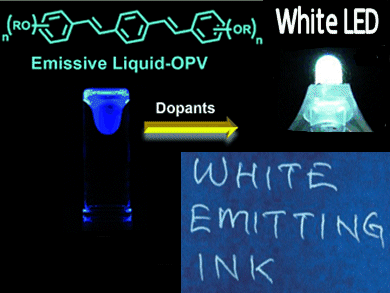New Way to Make Organic Electronics
The future will be dominated by organic electronics, as opposed to current silicon-based technology. In the journal Angewandte Chemie, an international team of researchers has now introduced a new luminescent organic liquid that can be applied like ink. When two additional dyes are dissolved in this liquid, it forms a white luminescent paste that may offer a new way to make devices like large displays and white light-emitting diodes (LEDs).
Current approaches to organic electronics mainly involve plastic film supports with conducting paths and components made of organic molecules inexpensively printed or glued on. Organic electronics are interesting as potential “disposable electronics” for applications like electronic price tags. Even more intriguing are devices that cannot be produced with standard electronics, such as flexible films with integrated circuits for use as novel flat-panel displays or “electronic paper”. A third area of interest involves applications such as photovoltaics that are dependent on economical mass production in order to be profitable.
The development of large components like displays requires organic coatings that emit white light and are inexpensive to produce. Previous gel- or solvent-based liquid “dyes” are easy to apply, but are often not colorfast or are barely luminescent after drying. For solids, on the other hand, processing is often too complex.
Solvent-Free Luminescent Liquid
A team led by Takashi Nakanishi at the National Institute for Materials Science in Tsukaba (Japan) has taken a different approach: they use uncharged organic substances that are luminescent liquids at room temperature and require no solvent. The electronically active parts of the molecules consist of linear chains of carbon atoms linked by π-conjugated double bonds. This means that electrons can move freely over a large portion of the molecule. The core is shielded by low-viscosity organic side chains that ensure that the core areas do not interact with each other and that the substance remains liquid.
The researchers were able to prepare a liquid that fluoresces blue under UV light. They then dissolved green- and orange-emitting dyes in this solvent-free liquid. This results in a durable, stable white-emitting paste whose glow can be adjusted from a “cool” bluish white to a “warm” yellowish white by changing the ratio of the dyes. It is possible to use this ink directly in a roller-ball pen for writing, or to apply it with a brush on a wide variety of surfaces. Application to a commercially available UV-LED allowed the researchers to produce white light-emitting diodes.
Image: © Wiley-VCH
- Solvent-Free Luminescent Organic Liquids,
S. S. Babu, J. Aimi, H. Ozawa, N. Shirahata, A. Saeki, S. Seki, A. Ajayaghosh, H. Möhwald, T. Nakanishi,
Angew. Chem. Int. Ed. 2012.
DOI: 10.1002/anie.201108853




